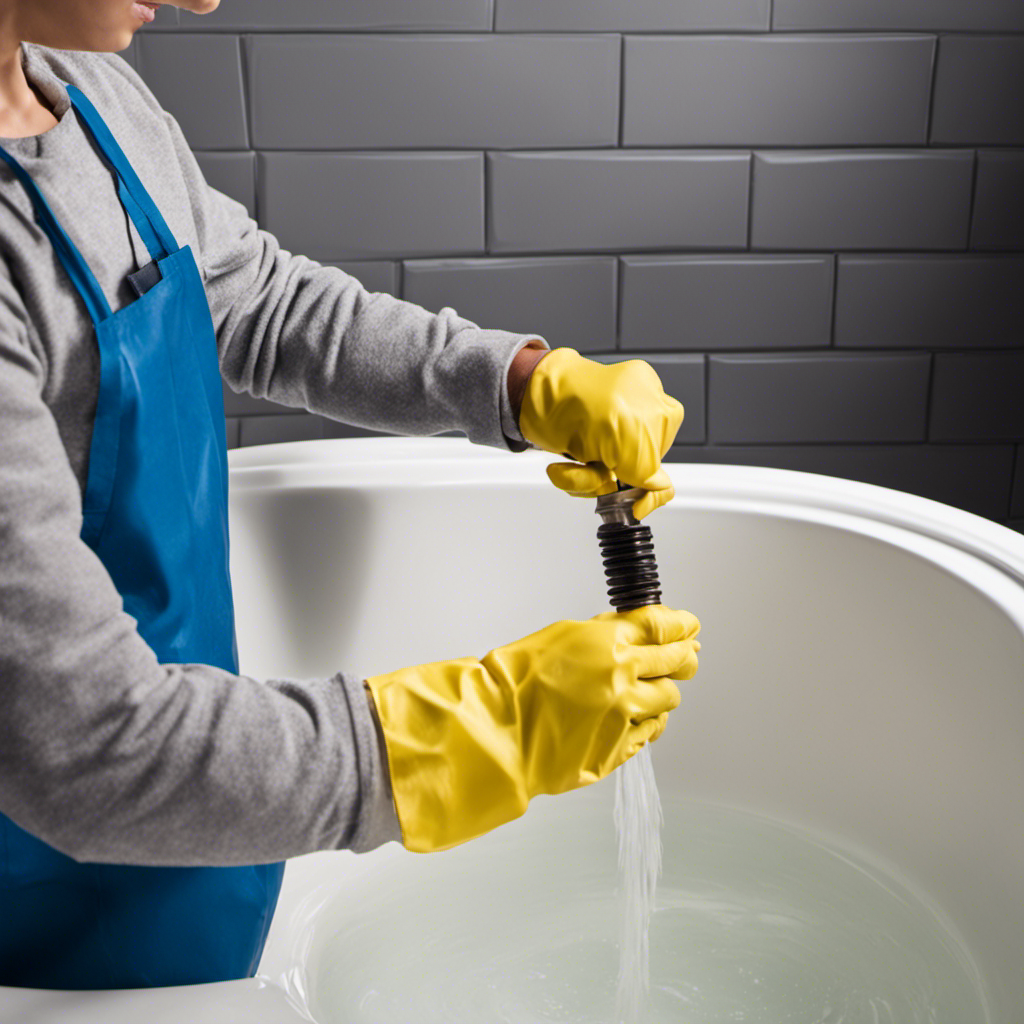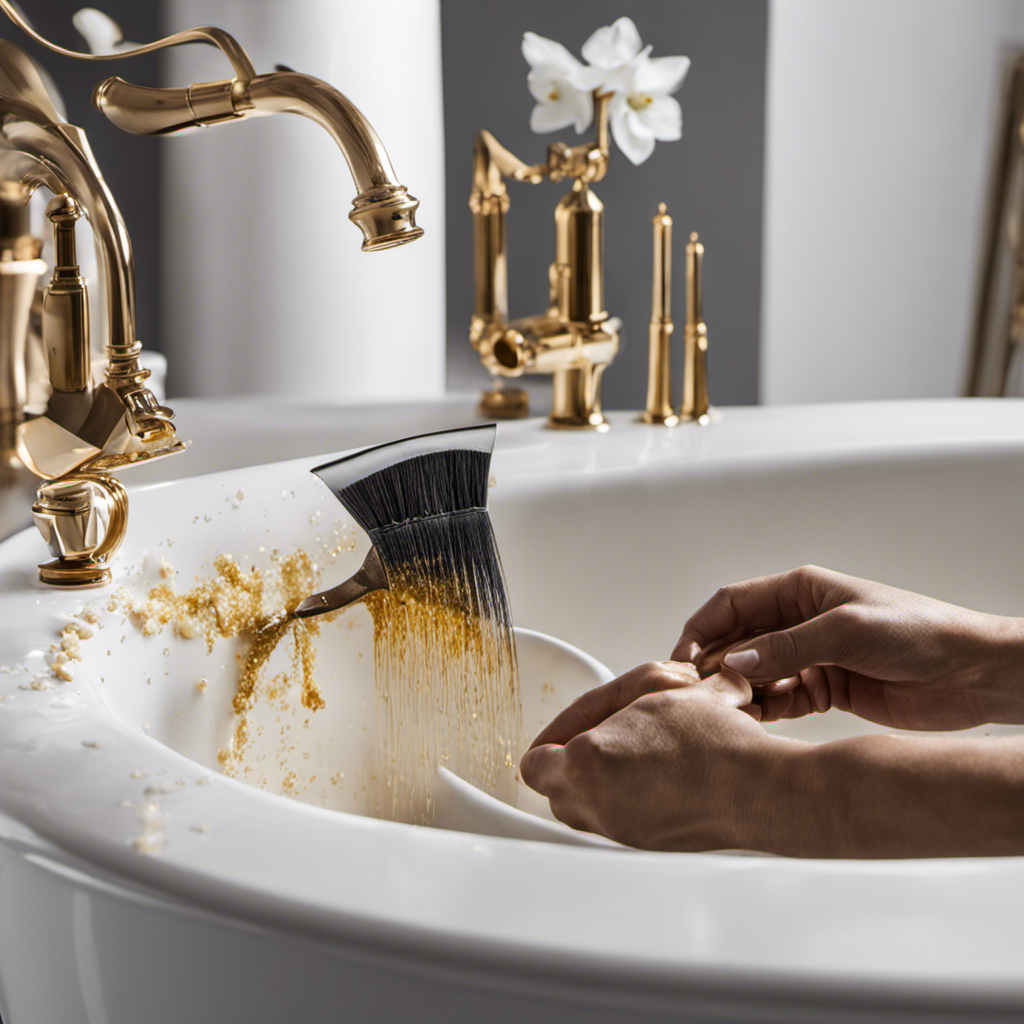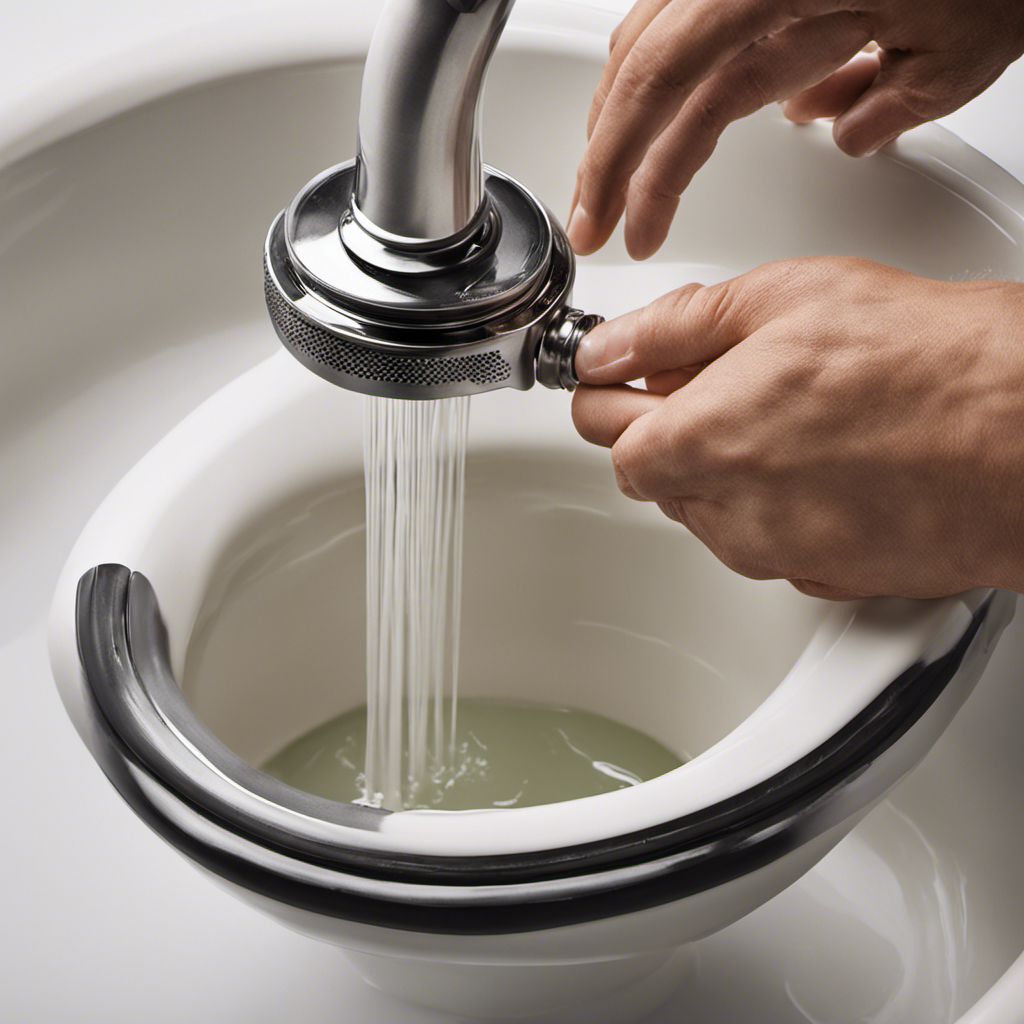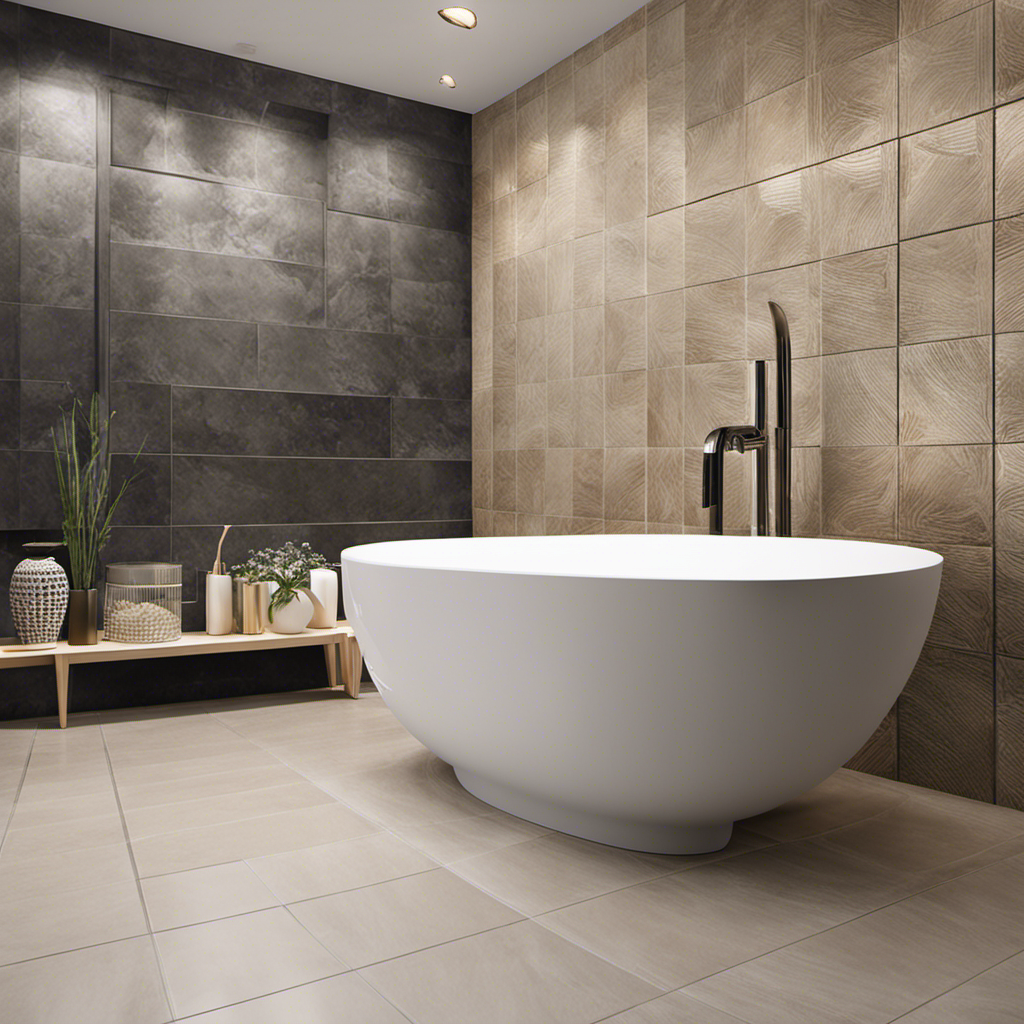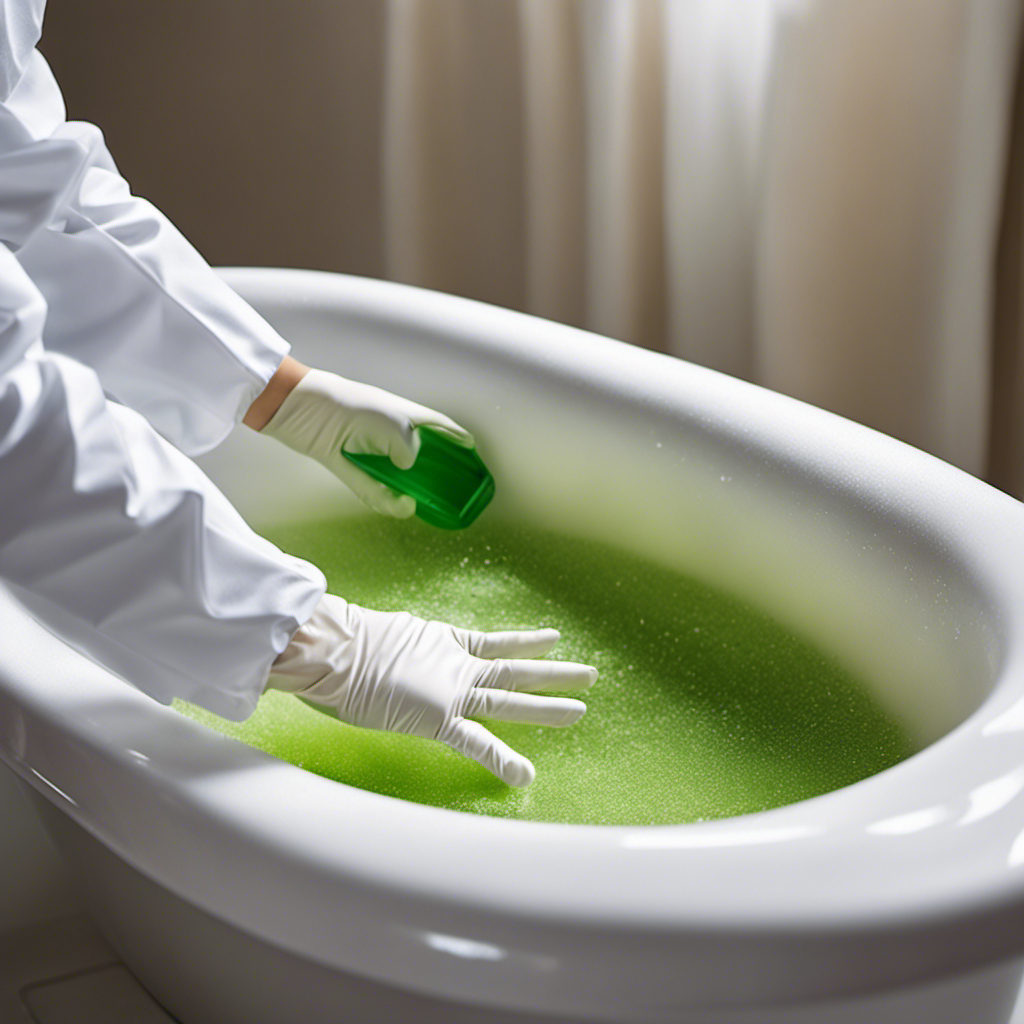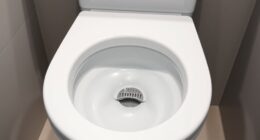Hey there! Having trouble with a clogged bathtub drain? No worries, I’ve got you covered.
In this article, I’ll walk you through the steps to fix that pesky drain and get your tub flowing smoothly again.
We’ll start by identifying the problem and gathering the necessary tools.
Then, I’ll show you how to remove the drain cover, clear out any hair and debris, and even use a plunger if needed.
So sit back, relax, and let’s dive into this tub drain fix together!
Key Takeaways
- Inspect the drain for visible obstructions like hair or soap residue.
- Use a plunger or a drain snake to dislodge clogs.
- Regularly use a drain strainer to catch debris and prevent future clogs.
- Avoid using harsh chemicals and stick to natural methods for clearing clogs.
Identifying the Problem
First, you’ll need to figure out what’s causing the bathtub drain to clog. To prevent rust and fix leaks, it’s important to identify the root cause of the problem.
Start by inspecting the drain for any visible obstructions, such as hair or soap residue. If the clog is not visible, a plunger can be used to try and dislodge it. If this doesn’t work, you may need to remove the drain cover and use a plumbing snake to reach deeper into the pipe.
In some cases, the clog may be due to a leak in the plumbing system, which can be fixed by tightening any loose connections or replacing damaged pipes.
Regular maintenance, such as using a drain strainer to catch debris, can help prevent rust and future clogs.
Gathering the Necessary Tools
To gather the necessary tools, you’ll need a screwdriver, pliers, and a drain wrench. These tools are essential for fixing a bathtub drain and ensuring a smooth and successful repair.
Here’s a step-by-step guide to gather the necessary tools:
-
Screwdriver:
-
Phillips or flathead, depending on the type of screws used in your drain cover.
-
Make sure the screwdriver is sturdy and in good condition to prevent rust or damage.
-
Pliers:
-
Adjustable pliers are ideal for gripping and turning stubborn parts.
-
Look for pliers with a comfortable grip to help prevent hand fatigue during the repair process.
-
Drain Wrench:
-
This specialized tool is designed to remove the drain basket or strainer.
-
Choose a drain wrench that fits your specific drain size for easier and more efficient unclogging.
Removing the Drain Cover
Using a screwdriver, you’ll be able to easily remove the drain cover. Start by locating the screws that hold the cover in place. They are usually located near the edges of the cover. Insert the screwdriver into the screw heads and turn counterclockwise to loosen and remove the screws.
Once the screws are removed, gently lift the drain cover off the drain opening. Be careful not to drop it into the drain.
Now that you have successfully removed the drain cover, you can proceed to identify the cause of the clog. One common cause of clogged bathtub drains is the buildup of hair and soap scum. If you suspect this is the cause, you can try using chemical cleaners specifically designed for clearing clogs in bathtub drains.
Clearing Out Hair and Debris
To prevent clogs in your bathtub drain, it’s important to take some preventive measures. One effective way to do this is by using a strainer to catch hair and debris before they can go down the drain.
Additionally, using a drain snake can help remove any existing clogs by physically breaking them up and pulling them out.
Another natural and cost-effective solution is to combine vinegar and baking soda. This creates a fizzing reaction that can help dissolve clogs and clear the drain.
Prevent Clogs With Strainer
You can prevent clogs in your bathtub drain by using a strainer. Strainers are an essential tool for maintaining a clean and clog-free drain.
Here are some important tips on strainer maintenance and choosing the right drain strainer:
-
Strainer Maintenance:
-
Regularly clean the strainer by removing any trapped hair or debris.
-
Rinse the strainer with warm water and mild soap to remove any buildup.
-
Choosing the Right Drain Strainer:
-
Look for a strainer with fine mesh to effectively catch hair and other small particles.
-
Consider a strainer with a durable construction to ensure long-lasting performance.
Use Drain Snake
If you’re dealing with a stubborn clog, a drain snake can be a helpful tool. It’s a flexible wire coil that can be inserted into your bathtub drain to dislodge and remove clogs. Here are some unclogging methods and maintenance tips you can use with a drain snake:
| Unclogging Methods | Maintenance Tips |
|---|---|
| Push and Twist: Insert the drain snake into the drain and push it down until you feel resistance. Twist the snake clockwise and pull it back to remove the clog. | Regular Cleaning: Use the drain snake regularly to prevent clogs from forming. Run hot water through the drain after each use to flush away any debris. |
| Plunger Technique: If the drain snake doesn’t work, try using a plunger. Create a tight seal around the drain and plunge vigorously to dislodge the clog. | Avoid Chemicals: Avoid using harsh chemicals to unclog your drain, as they can damage your pipes and be harmful to the environment. Stick to natural methods like the drain snake. |
| Professional Help: If all else fails, don’t hesitate to call a professional plumber. They have the experience and tools to handle even the most stubborn clogs. | Regular Maintenance: In addition to using the drain snake, regularly clean the drain strainer to prevent debris buildup. This will help keep your bathtub drain flowing smoothly. |
Vinegar and Baking Soda
Using vinegar and baking soda is a popular and effective method for unclogging drains. This natural solution can be a great alternative to harsh chemical cleaners and can help keep your drains flowing smoothly. Here is how you can use vinegar and baking soda to tackle a clogged drain:
- Pour half a cup of baking soda down the drain.
- Follow it with one cup of vinegar.
- Let the mixture bubble and fizz for about 15 minutes.
- Flush the drain with hot water to wash away the clog.
While vinegar and baking soda can be effective, there are also other alternatives you can try, such as using salt and boiling water or a mixture of lemon juice and salt. However, if these methods don’t work or if you prefer professional help, it’s always a good idea to contact a drain cleaning service.
They have the expertise and tools to tackle even the toughest clogs and ensure your drains are clear and functioning properly.
Using a Plunger
When it comes to using a plunger effectively, there are certain techniques that can make all the difference. In order to achieve the desired result, it’s important to understand the proper way to plunge a clogged drain.
Additionally, being aware of common mistakes to avoid can help prevent further damage and ensure a successful plunge.
Effective Plunging Techniques
To unclog a bathtub drain, start by applying downward pressure with a plunger. This simple tool can often clear stubborn clogs without the need for professional drain cleaning services. Follow these effective plunging techniques to tackle the problem yourself:
- Position the plunger over the drain, ensuring a tight seal.
- Push down firmly, then pull up quickly to create suction.
- Repeat this plunging motion several times to dislodge the clog.
- If the water starts to drain, continue plunging to fully clear the pipe.
If the clog persists, try using a plumbing snake or call a professional for further assistance.
Common Mistakes to Avoid
One common mistake is not ensuring a tight seal when positioning the plunger over the clogged area. This can significantly reduce the effectiveness of your plunging effort. To avoid this, make sure the plunger is fully covering the drain and create a tight seal by applying downward pressure. Another mistake to avoid is using excessive force while plunging. This can lead to damage to the drain or even cause it to detach from the pipe. Remember, a firm and controlled plunging motion is key. If you’ve tried these techniques and the clog persists, it may be time to seek professional help. They have the expertise and tools to diagnose and fix the issue without causing further damage.
| Common Mistakes to Avoid | Tips to Prevent Damage |
|---|---|
| Not ensuring a tight seal | Apply downward pressure |
| Using excessive force | Use a firm and controlled motion |
| Avoid seeking professional help | They have the expertise and tools to avoid further damage |
Using a Drain Snake
You’ll need a drain snake to clear the clog in your bathtub drain. A drain snake, also known as a plumber’s snake or auger, is a long, flexible tool used to remove blockages from pipes.
Here’s how you can use a drain snake effectively:
- Insert the snake into the drain, pushing it gently but firmly until you feel resistance.
- Rotate the snake clockwise while pushing it forward to break up the clog.
- Continue pushing and rotating the snake until you feel the clog loosen or break apart.
- Slowly retract the snake, pulling out any debris or clog material that comes with it.
- Repeat the process if necessary until the drain is clear.
Using a drain snake can be a cost-effective and efficient way to clear tough clogs in your bathtub drain. However, if you’re not comfortable doing it yourself or if the clog persists, it’s advisable to seek professional drain cleaning services for a thorough and effective solution.
Using a Homemade Drain Cleaner
Using a homemade drain cleaner can be a safe and natural alternative to harsh chemical cleaners. When it comes to clogged drains, there are eco-friendly drain cleaning methods that can effectively unclog the pipes without harming the environment.
One popular homemade drain cleaner alternative is a mixture of baking soda and vinegar. Simply pour half a cup of baking soda down the drain, followed by half a cup of vinegar. Let it sit for about 30 minutes, then flush it with hot water.
Another option is using a combination of salt, baking soda, and hot water. Mix half a cup of salt and half a cup of baking soda, then pour it down the drain. Follow it up with boiling water to flush away the clog.
These homemade drain cleaner alternatives are not only effective, but they are also safe and eco-friendly.
Checking the Overflow Plate
When it comes to checking the overflow plate in a bathtub, it’s important to understand its function and how it can contribute to a blocked drain.
The overflow plate serves as an extra outlet for water in case the tub starts to overflow, but it can also become a source of blockage if debris or hair gets trapped in it.
If you notice that your bathtub is draining slowly or not at all, it may be a sign that the overflow plate is blocked, and clearing the drain should be your next step to restore proper drainage.
Overflow Plate Function
The overflow plate is what prevents the bathtub from overflowing. It is an essential component of the bathtub drain system. Here is how it functions:
- The overflow plate is installed on the side of the bathtub, usually near the top.
- It has a cover plate that is attached to the overflow drain hole.
- A lever or a knob is connected to the cover plate, allowing you to open or close it.
- When the bathtub is filled with water, the overflow plate helps maintain the water level by allowing excess water to drain through the overflow drain hole.
- If the water level rises too high, the overflow plate ensures that the water flows into the overflow drain instead of flooding the bathroom floor.
To properly maintain and troubleshoot overflow plate issues, follow these steps:
- Regularly clean the overflow plate to prevent clogs and buildup.
- Check for any signs of leaks around the plate and fix them promptly.
- If the overflow plate is not functioning properly, make sure the lever or knob is not damaged or stuck.
- If needed, replace the overflow plate or seek professional assistance to resolve any issues.
Signs of Blockage
Now that we understand the function of the overflow plate, let’s discuss the signs of a blockage in your bathtub drain.
A blocked drain can manifest in several ways, causing inconvenience and potential damage to your plumbing system. One common sign is slow draining water, where you notice that the water takes longer than usual to empty from the bathtub.
Another indication is standing water in the tub after use. Foul odors emanating from the drain can also be a sign of blockage.
If you experience any of these signs, it’s important to address the issue promptly to avoid further complications. While there are DIY methods available to clear minor blockages, it is advisable to seek professional drain cleaning services for more stubborn or recurring issues.
These professionals have the expertise and specialized tools to effectively clear the blockage and ensure proper functioning of your bathtub drain.
Clearing the Drain
To clear the blockage in your bathtub, you can try using a plunger or a drain snake. Here are some steps you can follow:
-
Plunger method:
-
Fill the bathtub with enough water to cover the plunger’s rubber cup.
-
Place the plunger over the drain and push down firmly.
-
Pull up sharply to create suction and repeat this motion several times.
-
Check if the water starts to drain properly.
-
Drain snake method:
-
Insert the drain snake into the bathtub drain until you feel resistance.
-
Rotate the snake clockwise while pushing it further into the drain.
-
Keep rotating and pushing until you feel the snake break through the blockage.
-
Slowly pull out the snake, removing any debris along the way.
If these methods don’t work or if you’re uncomfortable doing it yourself, it’s best to seek professional help for clearing stubborn clogs.
Replacing the Drain Stopper
First, you’ll want to unscrew the drain stopper from the bathtub. This step is crucial in replacing the drain stopper and ensuring proper water flow.
When choosing the right drain stopper, there are a few factors to consider. Firstly, you’ll want to prevent rust from forming, as it can cause damage over time. Look for drain stoppers made from rust-resistant materials such as stainless steel or brass. Additionally, consider the type of drain stopper that best suits your needs. There are various options, including push-button, toe-touch, and lift-and-turn stoppers. Each type has its own advantages, so choose one that is easy to use and maintain.
By selecting the right drain stopper and preventing rust, you can keep your bathtub drain functioning properly for years to come.
To ensure proper water flow, the next step is to clean the drain thoroughly.
Ensuring Proper Water Flow
When cleaning the drain, make sure to remove any debris or clogs that may be obstructing the water flow. It is essential to prevent blockages in order to maintain proper water flow in your bathtub drain.
Here are some tips to ensure proper water flow maintenance:
-
Use a plunger: Place the plunger over the drain and push down firmly, then pull up quickly. Repeat this motion several times to dislodge any blockages.
-
Try a drain snake: Insert the drain snake into the drain and rotate it clockwise while pushing it further. This will help break up any stubborn clogs and clear the way for proper water flow.
Preventing Future Clogs
Now that we have addressed the issue of ensuring proper water flow in your bathtub drain, let’s discuss some maintenance tips to prevent future clogs.
Regular maintenance is key to keeping your drain clear and free from blockages.
Firstly, it is important to avoid letting hair, soap residue, and other debris go down the drain. Use a drain cover or strainer to catch any potential clog-causing material.
Secondly, be mindful of what you pour down the drain. Avoid pouring grease, oils, or food scraps down the drain as they can solidify and cause blockages.
Additionally, periodically flushing your drain with hot water can help to prevent build-up and keep the pipe clear. You can also try using a mixture of baking soda and vinegar to remove any build-up.
Frequently Asked Questions
Can I Use a Plunger to Fix a Bathtub Drain That Is Completely Clogged?
Yes, you can use a plunger to fix a completely clogged bathtub drain. It’s one of the alternative methods commonly used. Just make sure to create a tight seal and apply strong, consistent pressure to unclog the drain.
What Should I Do if Using a Plunger Does Not Work to Fix My Bathtub Drain?
If using a plunger doesn’t work, there are alternative solutions to fix a stubborn bathtub drain. However, if all else fails, it may be time to consider hiring a professional plumber for expert assistance.
How Often Should I Clean My Bathtub Drain to Prevent Future Clogs?
To prevent future clogs, it’s important to clean your bathtub drain regularly. I recommend cleaning it once a month using a mixture of baking soda, vinegar, and hot water. This will help keep your drain clear and functioning properly.
Can I Use a Drain Snake to Unclog a Bathtub Drain With a Difficult Blockage?
Yes, you can use a drain snake to unclog a bathtub drain with a difficult blockage. It’s an effective tool that can break up and remove stubborn clogs, even when chemicals or hot water don’t work.
Do I Need to Hire a Professional Plumber to Replace the Drain Stopper in My Bathtub?
I don’t need to hire a professional plumber to replace the drain stopper in my bathtub. It’s a DIY project that saves money. Just follow some tips and precautions to do it yourself.
Conclusion
In conclusion, fixing a bathtub drain is a relatively simple process that can save you time and money. By identifying the problem, gathering the necessary tools, and clearing out hair and debris, you can easily restore proper water flow.
Using a plunger and checking the overflow plate are additional steps that can help resolve the issue. Finally, replacing the drain stopper and taking preventative measures can ensure that future clogs are avoided.
So don’t let a clogged drain dampen your day, follow these steps and get your bathtub back in tip-top shape!
